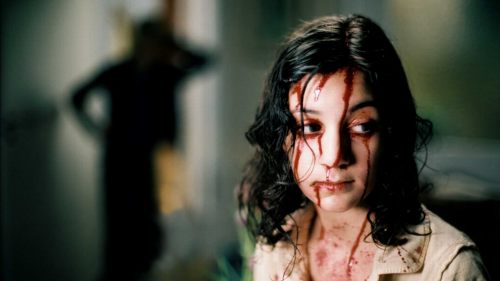The Lonely World of LET THE RIGHT ONE IN
Border is out now. Get your tickets here!
One of the most interesting elements of urban horror and fantasy is the important role of setting. Whether it’s a book, a comic, a TV show or a film, the cultures of where these stories take place seep into their very bones. Charlaine Harris’ Louisiana-set vampire books include extra doses of sultriness and old-world gentility. Neil Gaiman’s Sandman and Neverwhere combine modern British culture and the country’s ancient lore, allowing them to influence each other. His American Gods does the same with American mythology, both actual folktales and cultural attitudes grown from a history of assimilation, appropriation and half-truths.
Swedish writer John Ajvide Lindqvist’s work also fits this description. 2008’s Let the Right One In, and 2018’s Border, films adapted from Lindqvist’s stories, present what feel like distinctly Scandinavian takes on the urban horror and urban fantasy subgenres. The magical, the horrific and the everyday exist together, but there’s no beauty to it, or any allure, really. Much like the crime thrillers of fellow Scandinavians Jo Nesbø, Henning Mankell or Stieg Larsson, the strange and violent elements in both Lindqvist-based films are pretty matter-of-fact. They are heavily invested in the mundane and lonely aspects of his characters’ lives, whether those characters are average folks or fantastical beings.
As a film, Let the Right One In (which Lindqvist also wrote the screenplay for) sets a solid tone for what audiences can expect from the excellent and bizarre Border. In Let the Right One In, bullied twelve-year-old Oskar makes friends with Eli, a mysterious new girl in his apartment building who doesn’t feel the cold, only comes out at night and has been twelve for “a long time.” Eli’s a vampire, and relies on her older caretaker, Håkan, to pose as her father and drain humans of their blood for her to eat. Håkan’s a pathetically inept murderer, and Eli soon resorts to killing the building’s residents on her own, causing escalation that threatens her relationship with Oskar, just as Oskar is starting to rely on Eli for friendship and protection.
Let the Right One In is a slow burn that takes its time exploring its setting and characters, focusing on the lives of the building’s other tenants as well as Oskar and Eli. Everyone exudes a sense of deeply-ingrained sadness, whether they’re an ancient being trapped in a kid’s body, a lonely boy with violent revenge fantasies, or the crew of drunks who hang out at the local bar. Lindqvist and director Tomas Alfredson make these characters aggressively normal. We don’t know their personal lives in great detail, but the little we get tells us they’re pretty dull, and not very fulfilling.
This is evident in the limited locations and conversations of Lindqvist’s script, but also in the way Alfredson applies that script to the look of the film - the costumes, casting, sets and indeterminate (but definitely not contemporary) time period, as well as the movie’s perpetual Swedish winter. Let the Right One In’s middle-aged drunks look like just that - paunchy, poorly dressed and weirdly sweaty (compare this to the more attractive-looking neighbors in Matt Reeves’ fine-but-forgettable 2010 remake Let Me In). In every scene where Håkan appears, Alfredson focuses on actor Per Ragnar’s craggy face, making his wrinkles and pockmarks into a kind of lunar landscape.
Eli herself is far from the eerie beauty a story like Twilight teaches us to expect. She’s pale, yes, and otherworldly, but also kind of gross. She doesn’t bathe, and appears to dress in whatever she finds lying around. Eli’s hair is greasy, and there’s dried blood under her fingernails. One of the first things Oskar tells her when they meet is that she smells weird. If Eli ever did go through a glamorous vampire phase, the film suggests that time has long since passed. Just like everyone else around her, Eli no longer cares about anything but survival.
All of these elements coalesce into a take on urban horror and fantasy that de-romanticizes its supernatural elements, and makes us reconsider what draws us to these stories in the first place. If the appeal of escapist tales set in modern cities is to imagine a magical unknown world existing alongside our own, Lindqvist questions that appeal by taking away the barrier completely. His supernatural characters don’t exist adjacent to us, they exist with us, and their reality isn’t much different from yours or mine. There may be adventure or shock around the next corner, but more than likely, it’s just another lonely soul looking for connection.



